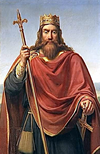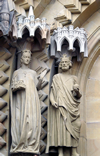The Franconians arose during the barbarian migration from germanic tribes living in the River Rhine area. Around 250 AD the have been mentioned first by Roman sources, called as "Francii" (= the free, the brave).
During the fourth century the Franconians settled in the northern of Brabant and spread over Flanders up to the North Sea. The colonization of Gaul started in the fifth century to the rivers Seine and Loire. From 455 AD on they settled in the area of the river Moselle and the Ardennes. 
Under the rule of King Clovis I the Franconians started to trek upstream the River Main.
This area is still today called „Franconia“.
The first important foundation of a town in that region was Wuerzburg around 560 AD.
Under the reign of Clovis`s sons the royal power decreased, due to the Franconian inheritance laws.
This led to the rise of the carolingian "Hausmeier" (from Latin"maioram" = the greater, the superior; German Name "Maier"; "Maire" = French mayor).
The first of these high officers of the royal court, who de facto bore the authority within the state, was Karl Martell, called the Hammer, who in 732 AD defeated in the battle of Tours und Poitiers the Arabs, who had intruded over Spain, and therby saved the occident from the islamic conquest.
His son Pepin depreciated the last king of the Merovingians and appointed himself King of the Franconians. Due to the Donation of Pepin and the security guarantee for the Papal State he recived the support of the Pope.
The biggest spread and the most political significance the Franconian Empire reached under the reign of Charlemagne.
As a reward for the protection of the Pope an the Church against the Visigoths in Northern Italy he was crowned emperor in 800 AD in St Peter`s Basilica in Rome and so succeeded the former Roman Caesars.
Despite his strict argue for Christianity Charlemagne never forgot his germanic roots and had old legends and narrations being collected; his son Louis the Pious annihilated the collections due to his religious officiousness.
While the Franconian Empire under the reign of Louis the Pious as the only heir remained stable, with his three sons the collapse started.
Advantaged by the franconian gavelkind and the cultural divergences, the empire was split in a germanic eastern part, today Germany, a middle part, Lorraine, and a romanic western part, today France. The middle part got Lothair I, the western part Charles the Bald, the eastern part Louis the German.
After the death of Lothair I Lorraine was parted among Charles and Louis by what the two parts finally became the independent Empires of France and Germany.
In this context the history of the term "deutsch" ("german") is interesting.
It has its origin in the old germanic word "theudisk" and was used as the latin word "theodiscum" as a name for the language of the germanic tribes in Gaul. Later it changed over to all germanic people within the Franconian Empire.
It means nothing else as "demotic", or "Language of the People".
Over the old high german word "diutisk" (engl. Dutch, nord. tysk, ital.tedesco, span. tudesco) it shaped to the Standard German term "deutsch".

In the year 1007 AD Henry II founded the diocese of Bamberg and equipped it with rich properties. Bamberg became a preferred palatinate and an important center of the empire. In the Dome of Bamberg reside the remains of Henry II and his wife as well as the remains of Pope Clemens II, a former bishop of Bamberg. It is the only pope`s grave north of the Alps.
Under Henry III the city of Nuremberg, in 1050 AD mentioned for the first time, was expanded to a new center of the kings authority. The target was to curtail the big influence of Bamberg.
During the reign of Louis IV, the Bavarian, the imperial city of Nuremberg took advantage of numerous new privileges. This made it both an economical and political important metropolis. So the imperial insignia have been kept in Nuremberg since 1423 AD.
To the end of the Middle Ages lots of little reigns and the imperial cities bloomed. A lot of buildings of the Gothic and Renaissance period originate from that time; for example the city halls of Coburg, Bamberg, Schweinfurt, Nuremberg; the fortress Marienberg in Wuerzburg, the fortress of Coburg, the St Sebald`s church, the St Lawrence`s church and the imperial castle of Nuremberg.
After the Pace of Augsburg of 1555 AD the particular sovereign of a region determined the religion of the area. So up to now the religious denomination in Franconia often changes from one village to another, sometimes in distances of only one or two kilometers.
Franconia, especially Nuremberg, played an important role in the spread of the Protestant Reformation of Martin Luther .
.
Well-known nurembergians like Albrecht Duerer have had close connections to the Protestant circles of Wittenberg.

During the counter-reformation Julius Echter in Wuerzburg and Neidhardt of Thuengen in Bamberg took reckless action against protestant circles. So especially in the two prince-bishoprics of Wuerzburg and Bamberg the worst crucibles in Europe took place.
These occurrences, besides other, led to the Thirty Years War that ended the epoch of economical and cultural height, especially of the imperial cities.
The imperial power existed nearly on the paper only, so also the imperial cities became meaningless step by step. The relocation of the global trade from the Meditteranean Sea to the Atlantic Ocean after the discovery of the seaways to India and the New World accelerated the decline.
Like everywhere in the empire now the big time of the residence cities began. Important architects like Balthasar Neumann created buildings like the residences of Bamberg, Wuerzburg, Ansbach and Bayreuth.
1803 AD Franconia came to the Kingdom of Bavaria, the imperial city of Nuremberg followed in 1806.
In the regions of Nuremberg, Schweinfurt and the area of Upper Franconia arose the most important industrial territories of Bavaria. During this time the three administrative regions of Upper-, Middle- and Lower Franconia have been formed by Count Montgelas under the influence of Napoleon.
At the time of the regime of the National Socialists parts of Franconia got own structures with the areas of Mainfranconia and Franconia; Upper Franconia had been pressed to the Bavarian East, together with Lower Bavaria and the Upper Palatinate.
Nuernberg, the city of the Nuremberg Rally ( the "Reichsparteitage") and the Nuremberg Laws, played a special role within the self-expression of the Nazis.
Due to this fact and the strong concentration of strategic industries in Franconia the cities of Nuremberg, Wuerzburg and Schweinfurt have been main targets for air raids of the allied airforces from 1940 to 1945 during the World War II.
For example in Nuremberg by itself the air raid of the 2nd of January 1945 did the hugest damages of the whole war; 521 bombers of the Royal Airforce dropped 6.000 demolition bombs and more than one million firebombs within half an hour.
The population of Nuremberg mourned a loss of 2.000 dead and more than 100.000 homeless on that attack. Ninety percent of the historic center of the city was destructed, the city as whole heavily affected.
The population of Nuremberg had decreased from 430.000 to 190.000 at the end of the war, half of the homes were destroyed, the rest often damaged.
After the war the trials against the war criminals of the Nazi regime took place in Nuremberg.
Around 1953 most of the reconstruction had been finished or at least begun. 1956 to 1960 the old city hall was reerected, 1957 the St Sebald`s church. The biggest project of the rebuilding was the old town forticication with its more than four kilometers long double wall and trench.
Today the Franconian cities are flourishing metropolises again; the franconian area with the Metroregion of Nuremberg generates a gross domestic product of 110 billions of Euro and so belongs to the economically strongest territories within Europe.


.

